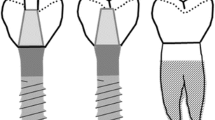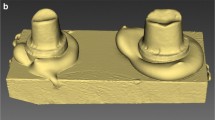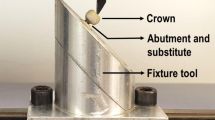Abstract
Objectives
In vitro investigation of the effects of fixed dental prosthesis (FDP) support and loading conditions on the fracture behavior of all-ceramic, zirconia-based FDP veneered with computer-aided design/computer-aided manufacturing (CAD/CAM)-manufactured lithium disilicate ceramic.
Materials and methods
Based on a model for a 3-unit FDP in the molar region (tooth in region 15, implant in region 17), 16 identical zirconia frameworks were fabricated and veneered with milled lithium disilicate ceramic. Another 16 FDPs were manufactured similarly, using a model in which the tooth was replaced by an implant. The specimens underwent 10,000 thermal cycles between 6.5 and 60 °C and 1,200,000 chewing cycles with a force magnitude of 100 N. All were then subsequently loaded until fracture in a universal testing device. Half of the FDPs were subjected to centric and axial loading on the pontic, the others to eccentric and oblique loading on one cusp of the pontic.
Results
No failures were observed after artificial aging. Fracture loads of tooth–implant-supported restorations were 1636 ± 158 and 1086 ± 156 N for axial and oblique loading, respectively; implant-supported FDPs fractured at 1789 ± 202 and 1200 ± 68 N, respectively. Differences were significant for load application (P < 0.001) and support type (P = 0.020). For the two types of load application, fracture mode differed substantially: complete fracture was observed for centric and axial loading whereas mixed cohesive/adhesive failure was observed for many FDPs loaded eccentrically and obliquely.
Conclusions
The high incidence of chipping of manually veneered implant-supported all-ceramics restorations might be reduced by use of CAD/CAM-manufactured lithium disilicate veneers.
Clinical Relevance
FDPs veneered with lithium disilicate resist occlusal forces of 500 N, irrespective of load application and support type. The fracture resistance of implant-supported FDPs was, however, higher than that of combined tooth–implant-supported FDPs. Their clinical use seems to be justified.










Similar content being viewed by others
References
Sailer I, Pjetursson BE, Zwahlen M, Hammerle CH (2007) A systematic review of the survival and complication rates of all-ceramic and metal-ceramic reconstructions after an observation period of at least 3 years. Part II: Fixed dental prostheses. Clin Oral Implants Res 18(Suppl 3):86–96. https://doi.org/10.1111/j.1600-0501.2007.01468.x
Rammelsberg P, Schwarz S, Schroeder C, Bermejo JL, Gabbert O (2013) Short-term complications of implant-supported and combined tooth-implant-supported fixed dental prostheses. Clin Oral Implants Res 24:758–762. https://doi.org/10.1111/j.1600-0501.2012.02482.x
Burke FJ, Crisp RJ, Cowan AJ, Lamb J, Thompson O, Tulloch N (2013) Five-year clinical evaluation of zirconia-based bridges in patients in UK general dental practices. J Dent 41:992–999. https://doi.org/10.1016/j.jdent.2013.08.007
Wittneben JG, Buser D, Salvi GE, Burgin W, Hicklin S, Bragger U (2014) Complication and failure rates with implant-supported fixed dental prostheses and single crowns: a 10-year retrospective study. Clin Implant Dent Relat Res 16:356–364. https://doi.org/10.1111/cid.12066
Konstantinidis IK, Jacoby S, Radel M, Boning K (2015) Prospective evaluation of zirconia based tooth- and implant-supported fixed dental prostheses: 3-year results. J Dent 43:87–93. https://doi.org/10.1016/j.jdent.2014.10.011
Pjetursson BE, Bragger U, Lang NP, Zwahlen M (2007) Comparison of survival and complication rates of tooth-supported fixed dental prostheses (FDPs) and implant-supported FDPs and single crowns (SCs). Clin Oral Implants Res 18(Suppl 3):97–113. https://doi.org/10.1111/j.1600-0501.2007.01439.x
Gunne J, Astrand P, Lindh T, Borg K, Olsson M (1999) Tooth-implant and implant supported fixed partial dentures: a 10-year report. Int J Prosthodont 12:216–221
Naert IE, Duyck JA, Hosny MM, Van Steenberghe D (2001) Freestanding and tooth-implant connected prostheses in the treatment of partially edentulous patients. Part I: An up to 15-years clinical evaluation. Clin Oral Implants Res 12:237–244
Block MS, Lirette D, Gardiner D, Li L, Finger IM, Hochstedler J, Evans G, Kent JN, Misiek DJ, Mendez AJ, Guerra L, Larsen H, Wood W, Worthington P (2002) Prospective evaluation of implants connected to teeth. Int J Oral Maxillofac Implants 17:473–487
Breeding LC, Dixon DL, Sadler JP, McKay ML (1995) Mechanical considerations for the implant tooth-supported fixed partial denture. J Prosthet Dent 74:487–492
Lang NP, Pjetursson BE, Tan K, Bragger U, Egger M, Zwahlen M (2004) A systematic review of the survival and complication rates of fixed partial dentures (FPDs) after an observation period of at least 5 years. II. Combined tooth–implant-supported FPDs. Clin Oral Implants Res 15:643–653. https://doi.org/10.1111/j.1600-0501.2004.01118.x
Hosny M, Duyck J, van Steenberghe D, Naert I (2000) Within-subject comparison between connected and nonconnected tooth-to-implant fixed partial prostheses: up to 14-year follow-up study. Int J Prosthodont 13:340–346
Gross M, Laufer BZ (1997) Splinting osseointegrated implants and natural teeth in rehabilitation of partially edentulous patients. Part I: laboratory and clinical studies. J Oral Rehabil 24:863–870
Lundgren D, Laurell L (1994) Biomechanical aspects of fixed bridgework supported by natural teeth and endosseous implants. Periodontology 4:23–40
Bragger U, Aeschlimann S, Burgin W, Hammerle CH, Lang NP (2001) Biological and technical complications and failures with fixed partial dentures (FPD) on implants and teeth after four to five years of function. Clin Oral Implants Res 12:26–34
Beuer F, Schweiger J, Eichberger M, Kappert HF, Gernet W, Edelhoff D (2009) High-strength CAD/CAM-fabricated veneering material sintered to zirconia copings—a new fabrication mode for all-ceramic restorations. Dent Mater 25:121–128. https://doi.org/10.1016/j.dental.2008.04.019
Schmitter M, Schweiger M, Mueller D, Rues S (2014) Effect on in vitro fracture resistance of the technique used to attach lithium disilicate ceramic veneer to zirconia frameworks. Dent Mater 30:122–130. https://doi.org/10.1016/j.dental.2013.10.008
Aboushelib MN, Feilzer AJ, Kleverlaan CJ (2009) Bridging the gap between clinical failure and laboratory fracture strength tests using a fractographic approach. Dent Mater 25:383–391. https://doi.org/10.1016/j.dental.2008.09.001
Gabbert O, Karatzogiannis E, Ohlmann B, Schmitter M, Karl J, Rammelsberg P (2012) Fracture load of tooth-implant-retained zirconia ceramic fixed dental prostheses: effect of span length and preparation design. Clin Oral Implants Res 23:719–725. https://doi.org/10.1111/j.1600-0501.2011.02191.x
Schmitter M, Mueller D, Rues S (2012) Chipping behaviour of all-ceramic crowns with zirconia framework and CAD/CAM manufactured veneer. J Dent 40:154–162. https://doi.org/10.1016/j.jdent.2011.12.007
Vult von Steyern P, Kokubo Y, Nilner K (2005) Use of abutment-teeth vs. dental implants to support all-ceramic fixed partial dentures: an in-vitro study on fracture strength. Swed Dent J 29:53–60
Christensen RP, Ploeger BJ (2010) A clinical comparison of zirconia, metal and alumina fixed-prosthesis frameworks veneered with layered or pressed ceramic: a three-year report. J Am Dent Assoc 141:1317–1329
Guess PC, Zavanelli RA, Silva NR, Bonfante EA, Coelho PG, Thompson VP (2010) Monolithic CAD/CAM lithium disilicate versus veneered Y-TZP crowns: comparison of failure modes and reliability after fatigue. Int J Prosthodont 23:434–442
Buso L, Oliveira-Junior OB, Hiroshi Fujiy F, Leao Lombardo GH, Ramalho Sarmento H, Campos F, Assuncao Souza RO (2011) Biaxial flexural strength of CAD/CAM ceramics. Minerva Stomatol 60:311–319
Kamposiora P, Papavasiliou G, Bayne SC, Felton DA (1996) Stress concentration in all-ceramic posterior fixed partial dentures. Quintessence Int 27:701–706
Larsson C, Holm L, Lovgren N, Kokubo Y, Vult von Steyern P (2007) Fracture strength of four-unit Y-TZP FPD cores designed with varying connector diameter. An in-vitro study. J Oral Rehabil 34:702–709. https://doi.org/10.1111/j.1365-2842.2007.01770.x
Sundh A, Molin M, Sjogren G (2005) Fracture resistance of yttrium oxide partially-stabilized zirconia all-ceramic bridges after veneering and mechanical fatigue testing. Dent Mater 21:476–482. https://doi.org/10.1016/j.dental.2004.07.013
Att W, Grigoriadou M, Strub JR (2007) ZrO2 three-unit fixed partial dentures: comparison of failure load before and after exposure to a mastication simulator. J Oral Rehabil 34:282–290. https://doi.org/10.1111/j.1365-2842.2006.01705.x
Rosentritt M, Behr M, Gebhard R, Handel G (2006) Influence of stress simulation parameters on the fracture strength of all-ceramic fixed-partial dentures. Dent Mater 22:176–182. https://doi.org/10.1016/j.dental.2005.04.024
Ernst CP, Canbek K, Euler T, Willershausen B (2004) In vivo validation of the historical in vitro thermocycling temperature range for dental materials testing. Clin Oral Investig 8:130–138. https://doi.org/10.1007/s00784-004-0267-2
Ohlmann B, Gabbert O, Schmitter M, Gilde H, Rammelsberg P (2005) Fracture resistance of the veneering on inlay-retained zirconia ceramic fixed partial dentures. Acta Odontol Scand 63:335–342
De Boever JA, McCall WD Jr, Holden S, Ash MM Jr (1978) Functional occlusal forces: an investigation by telemetry. J Prosthet Dent 40:326–333
Kolbeck C, Behr M, Rosentritt M, Handel G (2008) Fracture force of tooth-tooth- and implant-tooth-supported all-ceramic fixed partial dentures using titanium vs. customised zirconia implant abutments. Clin Oral Implants Res 19:1049–1053. https://doi.org/10.1111/j.1600-0501.2008.01551.x
Coelho PG, Bonfante EA, Silva NR, Rekow ED, Thompson VP (2009) Laboratory simulation of Y-TZP all-ceramic crown clinical failures. J Dent Res 88:382–386. https://doi.org/10.1177/0022034509333968
Acknowledgements
The authors thank Ivoclar Vivadent AG and Straumann AG for supplying the materials and Sirona Dental Systems GmbH for technical support with fabrication of FDPs.
Funding
The work was supported by the Department of Prosthodontics, Heidelberg University, Germany.
Author information
Authors and Affiliations
Corresponding author
Ethics declarations
Conflict of interest
The authors declare that they have no conflict of interest.
Ethical approval
This article does not contain any studies with human participants or animals performed by any of the authors.
Informed consent
For this type of study, formal consent is not required.
Rights and permissions
About this article
Cite this article
Alkharrat, A.R., Schmitter, M., Rues, S. et al. Fracture behavior of all-ceramic, implant-supported, and tooth–implant-supported fixed dental prostheses. Clin Oral Invest 22, 1663–1673 (2018). https://doi.org/10.1007/s00784-017-2233-9
Received:
Accepted:
Published:
Issue Date:
DOI: https://doi.org/10.1007/s00784-017-2233-9




